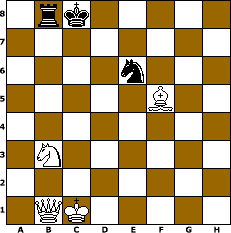
In chess, a pin is a situation in which a piece is forced to stay put because moving it would expose a more valuable piece behind it to capture.
In the diagram to the right, the black knight is pinned to the king by the white bishop. This is an absolute pin, because the rules forbid moving the knight, as it would expose the king to attack.
The black rook is pinning the white knight to the queen. This is a relative pin; White is unlikely to move the knight because this would lose the queen, a far more valuable piece—but White still has the choice.
The act of breaking a pin is unpinning. This can be executed in a number of ways: the piece effecting the pin can be captured; a piece can be put between the pinning unit and the pinned unit; a piece can be put between the pinned unit and the unit to which it is pinned; or the unit to which a piece is pinned can be moved.
A pin that often occurs in openings is the move Bb5 (see algebraic chess notation) which, if Black has moved their d-pawn, pins the knight on c6, because moving the knight would expose the king on e8 to check. A common way to win the queen is to pin her to the king with a rook: for instance with a white rook on e1, the black queen on e7 and the Black king on e8.
|
